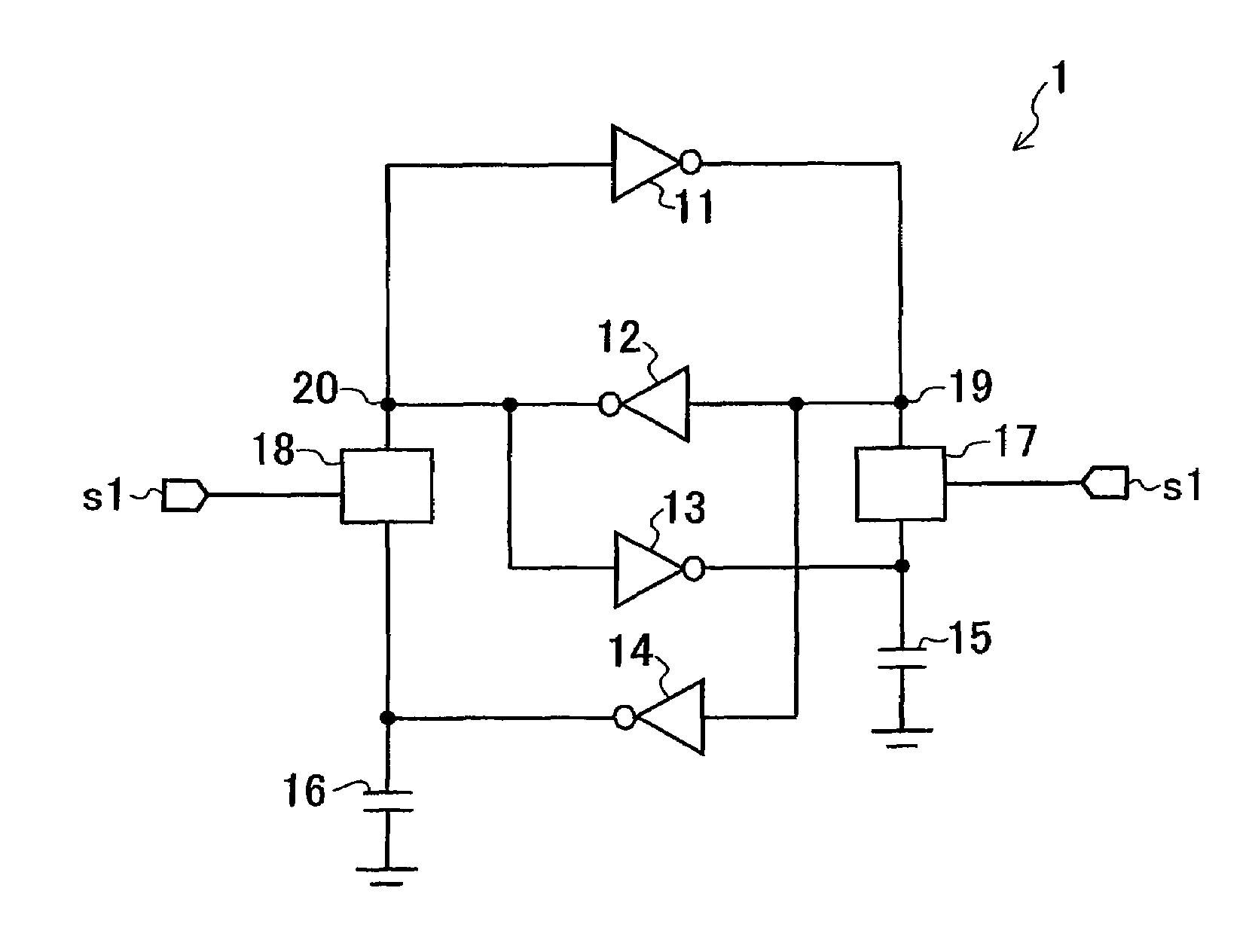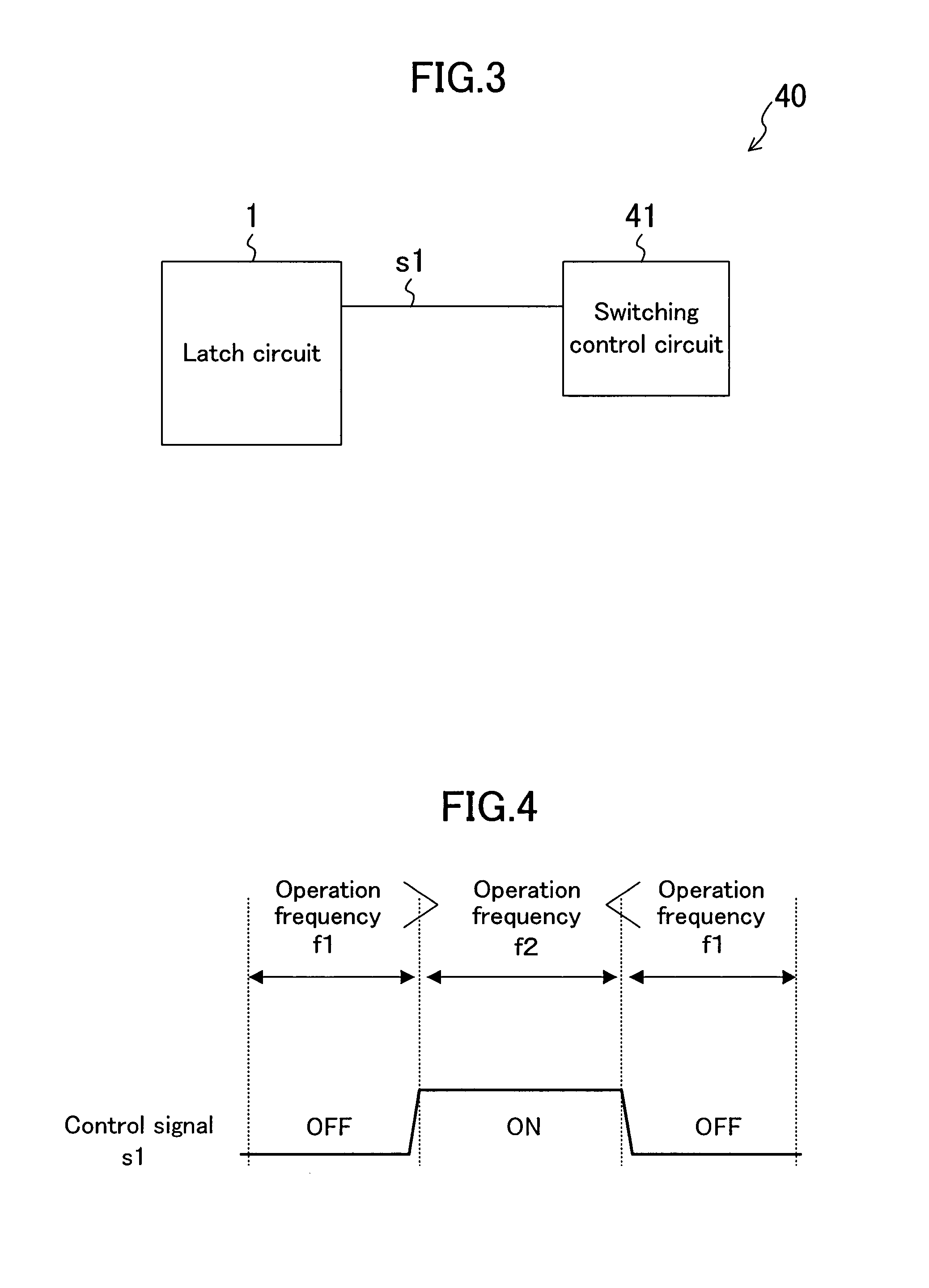Latch circuit and semiconductor integrated circuit having the same
a technology of latch circuit and integrated circuit, which is applied in the field of latch circuit, can solve the problems of data inversion caused by noise generated by a reduction in voltage, soft error, data inversion, etc., and achieve the effect of increasing the degree of integration of the circui
- Summary
- Abstract
- Description
- Claims
- Application Information
AI Technical Summary
Benefits of technology
Problems solved by technology
Method used
Image
Examples
first embodiments
[0035]FIG. 1 shows an example of a configuration of a latch circuit according to a first embodiment. A latch circuit 1 includes inverter circuits 11, 12, 13, and 14, capacitor elements 15 and 16, and switching elements 17 and 18. The latch circuit 1 holds data in storage nodes 19 and 20 serving as connection points of the inverter circuit 11 and 12 which are cross-connected to each other. A configuration to hold data is not limited to the above configuration.
[0036]The inverter circuits 13 and 14 receive outputs from the inverter circuits 12 and 11, logically invert the outputs to output the logically inverted outputs, respectively. The inverter circuits 13 and 14 may be tristate inverter circuits (see, FIG. 13). In the tristate inverter circuit, an output can have a high impedance. For this reason, charging / discharging at the output terminal of the tristate inverter circuit can be suppressed, and a power consumption can be reduced.
[0037]The capacitor elements 15 and 16 are connected...
second embodiment
[0046]FIG. 2 shows an example of a configuration of a semiconductor integrated circuit according to a second embodiment. A semiconductor integrated circuit 30 includes the latch circuit 1 described above, a clock gate circuit 31, and an input control circuit 32.
[0047]The clock gate circuit 31 receives the control signal s1 of the switching elements 17 and 18 to control the presence / absence of outputting of an input clock signal ck on the basis of the control signal s1. In other words, by a control signal used in clock gated, the switching elements 17 and 18 are controlled. The input control circuit 32 controls the presence / absence of inputting of a data signal da to the latch circuit 1 in synchronism with an output signal s2 from the clock gate circuit 31. More specifically, the logical level of the signal s1 is set at “H” to instruct the discontinuation of the clock signal ck. At this time, since the clock gate circuit 31 transmits the clock signal ck, the input control circuit 32 ...
third embodiment
[0049]FIG. 3 shows an example of a configuration of a semiconductor integrated circuit according to a third embodiment. A semiconductor integrated circuit 40 includes the latch circuit 1 described above and a switching control circuit 41. The switching elements 17 and 18 are controlled by a control signal s1 output from the switching control circuit 41. An example of control of the semiconductor integrated circuit according to the embodiment will be described below.
First Example Of Control
[0050]FIG. 4 shows a first example of control of the latch circuit 1. The switching control circuit 41 sets the logical level of the control signal s1 at “H” when an operation frequency of the latch circuit 1 is switched from f1 to f2, and controls the switching element to an ON state. On the other hand, when the operation frequency of the latch circuit 1 is switched from f2 to f1, the switching control circuit 41 sets the logical level of the control signal s1 at “L” to control the switching eleme...
PUM
 Login to View More
Login to View More Abstract
Description
Claims
Application Information
 Login to View More
Login to View More - R&D
- Intellectual Property
- Life Sciences
- Materials
- Tech Scout
- Unparalleled Data Quality
- Higher Quality Content
- 60% Fewer Hallucinations
Browse by: Latest US Patents, China's latest patents, Technical Efficacy Thesaurus, Application Domain, Technology Topic, Popular Technical Reports.
© 2025 PatSnap. All rights reserved.Legal|Privacy policy|Modern Slavery Act Transparency Statement|Sitemap|About US| Contact US: help@patsnap.com



